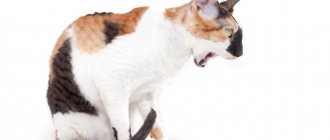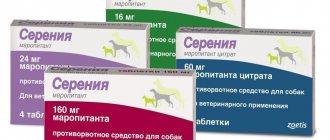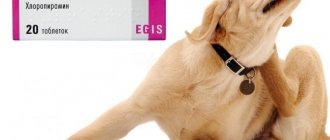Vomiting in a cat: causes, first aid, treatment and prevention
The process of vomiting in a cat is no different in nature from vomiting in a person: thus, the stomach rejects the substances that have entered it and throws them out of the body through the mouth or nose.
Vomiting is a protective reaction that clears the gastrointestinal tract of foreign or toxic contents.
The appearance of this symptom in most cases indicates a disturbance in the functioning of the digestive system, when the stomach cannot digest the substances that enter it.
Causes of vomiting
Vomiting in a cat can be caused by many reasons, both everyday and truly dangerous - in some cases it is a symptom of serious diseases that can significantly harm the cat's condition or even lead to death. Treatment of vomiting must begin with a correct determination of the cause of its manifestation, otherwise the methods used may turn out to be completely ineffective or even worsen the situation.
Household causes of vomiting (quite natural and do not pose a serious threat to the health of the animal):
- in one meal the cat ate a large amount of food for its stomach;
- swallowing large pieces too quickly;
- accumulation of hair in the stomach (regular ridding of the body from hairballs that enter it during licking is a natural process);
- rejection of grass by the stomach (cats instinctively eat some herbs themselves to cleanse the gastrointestinal tract of toxins).
In some cases, vomiting is a symptom of dangerous diseases (they can cause severe harm to the animal’s health or even lead to death):
- malignant tumors (oncology);
- plague;
- acute form of gastrointestinal tract diseases;
- viral infection;
- ketosis;
- acute toxic poisoning;
- worms;
- diabetes.
Another possible reason that a cat burps is the body’s reaction to the treatment of a disease (if medications with strong effects are used that cause a stress reaction in the body).
Types of vomit
You can determine the cause of vomiting and plan a further plan for its treatment, first of all, by studying the nature of the discharge. Based on the accompanying signs, you can find out what exactly caused the stomach rejection.
Impurities in vomit are of the following types:
- Bile and vomit are yellow. Such discharge is a pathology, because Bile should not be released from the stomach on its own. Such vomiting is most often caused by too long a urge, when the stomach is already completely emptied; other possible causes are diseases of the gallbladder and biliary tract.
- Green impurities. All green discharge is a sign of severe pathology in the body, in particular, intestinal obstruction or inflammation of the bile ducts, because It is the high bile content that gives vomit its characteristic green color.
- Blood impurities. Can be of different saturations. If there is a small amount of blood and the vomit is light red or pink, this indicates minor damage to the mucous membrane of the oral cavity, pharynx or esophagus. If the vomit is a rich or dark red color, then this is caused by severe internal bleeding in the intestines.
- Wool. If hair in vomit is seen in tufts or many individual hairs, while no other impurities are observed, then the owner of the animal has no reason to worry, because by secreting vomit, the cat’s body simply gets rid of the indigestible hair that has entered the stomach.
- Leftover food. If all that is excreted in the vomit is undigested food without additional impurities, then the cause of vomiting is overeating or the animal swallowing large pieces too quickly. There is no need to worry, just reconsider your pet’s diet a little.
- White foamy discharge. Such vomiting is not dangerous if it is one-time in nature. Its reason is that there is an excess of gastric juice in the stomach, which simply has nothing to digest; it collects into white foam and is excreted from the body.
- Slime. Mucous discharge is a symptom characteristic of gastric ulcers or acute forms of gastritis.
- Fecal impurities. excrement in the vomit is a very alarming symptom, indicating possible peritonitis, intestinal obstruction or internal damage to the abdominal cavity.
Owners of furry friends should keep in mind that even if they carefully study the nature of vomit, it is still impossible to draw clear conclusions based only on the presence (or absence) of certain impurities in the vomit.
In order to have a more accurate idea of your cat’s health, you also need to pay attention to the following factors:
- frequency of vomiting;
- the pet’s desire to drink as much water as possible;
- maintaining appetite;
- manifestation of other signs of poisoning (diarrhea, dehydration);
- general well-being of the pet (appearance of lethargy, constant fatigue, lack of interest in what is happening around).
Vomiting in a pregnant cat and small kittens
Just like in humans, pregnant cats' bodies are under stress and have increased sensitivity. That is why toxicosis and morning vomiting are absolutely normal for future furry mothers.
They are explained by the fact that for a pregnant cat the entire environment becomes too toxic, and the rejecting reaction of her body is completely conditioned.
The stomach of a pregnant cat may reject food due to the fact that the fetus puts strong pressure on the internal organs.
Owners of pregnant cats should definitely pay attention to the appearance of impurities in the vomit - as long as they are absent, there is no reason for alarm, but if blood, bile, mucus, etc. appear. – to preserve the health of the cat and its future offspring, it is necessary to contact a veterinarian as soon as possible!
In small kittens, nausea, as a rule, is not a signal of a serious pathology (except in cases where vomiting occurs very often, and there are dangerous impurities in the masses).
The two most common reasons why a kitten vomits:
- After eating, the cub plays too actively and makes a lot of intense movements, which significantly complicates the digestion process, and, accordingly, not all the food eaten is digested;
- a kitten has a slight pathology from birth - due to the incorrect position of the sphincter, its stomach cannot fully digest all the incoming food, and in order for the stomach to cope and no more vomiting, you just need to reduce the portions for each feeding.
Urgent visit to the veterinarian
The information given above divides the causes of vomiting into two conditional categories: dangerous (manifestation of serious diseases) and not dangerous (removal of foreign objects, excess gastric juice, cleansing the body, etc.).
If a cat vomits once or recurs with some regularity, the owner needs to determine how serious the symptoms are and, accordingly, decide whether immediate contact with a veterinarian is necessary or not.
You should seek veterinary help as soon as possible if:
- the cat vomits often and in large quantities, even after the stomach is completely emptied, the animal does not stop urge;
- impurities characteristic of dangerous diseases are constantly present in the discharge
- the pet’s general condition is lethargic, he constantly wants to sleep, he loses his appetite and interest in the world around him;
- there are accompanying symptoms of poisoning - diarrhea, fever, fever;
- The pet's condition is rapidly deteriorating.
When going to the veterinarian, it is better to make an appointment by calling in advance so as not to waste time in queues.
With certain diseases, hours and even minutes count – the sooner the veterinarian intervenes, the greater the pet’s chances of recovery.
You must take with you all the necessary documents of the animal (their availability and quantity depends on the breed and the club to which the cat belongs). It is also recommended to take a sample of vomit with you to make a diagnosis as quickly as possible.
First aid for a pet
You can also help your cat at home. If signs of dangerous vomiting are detected, the following measures should be taken immediately:
- Immediately stop the toxic substance from entering the body. Effective if vomiting is caused by poisoning. If the owner does not know exactly what exactly caused the dangerous symptom, the pet should be closely monitored before contacting a doctor and any attempts by the animal to eat anything should be stopped.
- The cat's body must exclude the possibility of dehydration. To do this, you must constantly offer your pet clean water. If he does not feel thirsty and does not drink on his own, he must be given water by force, the main thing is that a sufficient amount of liquid is always present in the weakened body. The exception is the case when water provokes new vomiting.
- If you suspect that the cat has swallowed some foreign object, and it is this that is causing vomiting, you can examine the animal’s throat yourself. If you find a foreign body, but find it difficult to remove it yourself, you should immediately contact a veterinarian - if you risk doing it yourself, you may injure your pet.
Treatment
The main rule for treating a pet when vomiting occurs is the absence of independent diagnosis and the use of unknown drugs. Only a professional veterinarian can determine the cause of vomiting and prescribe treatment; making such decisions independently is negligence towards the pet.
For vomiting caused by various reasons, pets are prescribed one of the following medications:
- antispasmodics;
- gastroprotectors;
- antiemetics.
The choice of treatment method is always selected by the veterinarian for each individual case. For example, in some situations, for recovery it will be enough to keep your pet on a diet for only a few days, in others it is impossible to do without surgical intervention.
To accurately determine the diagnosis at the veterinary clinic, specialists take a number of tests: urine, blood, saliva, feces, etc. Based on their results, it is possible to better determine what caused the vomiting and prescribe effective treatment.
about the causes of vomiting in cats:
Pet diet
Having made a diagnosis and carried out the necessary procedures in the clinic, the doctor will definitely give individual recommendations on diet. There are also general principles for feeding your pet when vomiting:
- On the first day, the cat should not eat at all. Any food must be excluded so as not to irritate the weakened intestines. Water should be limited if it provokes new spasms in the cat. To avoid dehydration, it is recommended to let your pet lick an ice cube.
- Further nutrition should not be difficult for the gastrointestinal tract. It is recommended to make a diet from boiled rice, baby puree, soft-boiled eggs, boiled chicken and low-fat cottage cheese.
- Portions should be small and meals should be frequent.
- If you feed your pet dry food, then during the period of exacerbation of the disease it must be replaced with medicinal food.
Vomiting is not always a terrible thing; it is often just a natural reaction of the body and should not cause alarm. However, you need to carefully monitor your pet's health, and if this symptom recurs with some regularity, then it is very important to consult a doctor in a timely manner so that the situation does not worsen.
Source: https://kotoholik.com/veterinaria/rvota-u-koshki.html
How to make a cat vomit
Why is my cat vomiting? This phenomenon is one of the clearest symptoms that something is wrong with the animal. For what reasons does it occur and what diseases may it indicate? Let's look at the main causes of vomiting in cats.
Starvation
If we talk about pets, then most often hungry vomiting is recorded in the morning, when the stomach is empty after the night. As soon as the animal is fed or even given a drink, the vomiting stops.
Binge eating
Often your cat may vomit after eating. And this is the other side of the coin. When the stomach is full, its contents cannot pass into the intestines (after all, the food must be digested) and it returns. And then the cat vomits after eating. Of course, since this food could not fit into the stomach, the cat vomits food or undigested food.
The cat is throwing up hair
Almost every owner of a purring dog in his life has encountered the phenomenon of a cat vomiting hair. There's nothing wrong with that. The pet licks itself, the hairs willy-nilly end up in the gastrointestinal tract, which cannot digest the hair.
This hair ball will not pass throughout the intestine, so the vomiting center (and it is present in every mammal’s brain) will give a “command” and reverse peristalsis will begin (that is, the entire contents of the intestine will not go towards the anus, as expected, but will go towards to the mouth). As a result of all this, vomiting begins. This is how hairballs come out of the cat.
If this does not happen, then over time a pilobezoar will form in the intestines - a dense ball of hair that will clog the digestive tract. Food will no longer be able to move through the gastrointestinal tract, and severe intoxication of the body may begin. The animal will be in great pain. It is not uncommon for a cat to vomit food or undigested food because there is nowhere for the food to “move.”
Such a hair ball can only be removed surgically. Therefore, it is extremely important to give the animal special food that helps remove licked fur from the digestive tract. And be sure to brush your pet regularly. Especially during periods of heavy molting.
Poisoning
Vomiting in cats is a defensive reaction. And if your pet is poisoned, then vomiting will help remove toxins from the body as quickly as possible so that they do not have time to be absorbed and cause harm to the body. But usually vomiting in cats that have been poisoned is accompanied by diarrhea. The intestines are cleansed from all sides at a fast pace.
However, there is a high risk of dehydration. Purr urgently needs help! Poisoning is especially dangerous for young animals and a pregnant cat. If you have this particular case, we recommend reading what to do in case of poisoning in cats.
Vomiting in a pregnant cat
It is no secret that the uterus increases in size while expecting offspring. Due to the fact that there is not much space in the abdominal cavity, other internal organs are compressed and displaced. In addition, during the period of bearing children, the expectant mother has a real hormonal riot. Therefore, vomiting is sometimes observed in a pregnant cat.
But you shouldn’t attribute everything just to a compressed stomach or a change in hormonal levels, especially if the cat vomits very often. Often this becomes a serious symptom. Your pet may have an infectious disease or parasites.
Although sometimes diarrhea and vomiting in a cat begins just before birth - a kind of harbinger, but not always.
Therefore, if you notice that a pregnant cat has started vomiting, it is better to contact a veterinarian so as not to risk the life of either the mother or the babies.
Infectious and parasitic diseases
Don't forget about them. After all, intestinal parasites are often the reason why a cat’s diarrhea and vomiting practically never stop. Be sure to pay attention to other symptoms. Indeed, with an infectious etiology in a pet, you will notice an increase in body temperature, a change in behavior, and discharge from the eyes and nose. There may be a cough, runny nose.
It all depends on the pathogen and where it is localized. It will also be important to examine the cat’s vomit. Don’t be disdainful, because if there is blood or bile in them, then this will already tell you what the animal may have. In addition, when a veterinarian takes a medical history, such details will really narrow down the range of suitable diseases.
Different types of vomit in a cat: what do they indicate?
Attention: below are examples of vomiting in cats in the photo. Do not watch for the faint of heart or impressionable! As surprising as it may sound, vomiting in cats varies. And it is precisely by its characteristics that a diagnosis can presumably be made.
Yellow vomit in a cat
It is extremely rare that yellow vomit in a cat appears due to the coloring of the vomit with dyes from food (often due to feeding with industrial dry food). A cat often vomits yellow, not because of food, but because of bile.
Cat vomits bile
Unlike simply yellow vomit, bile has a bright tint. Therefore, it is extremely difficult to confuse it with something else. It usually occurs in those animals that have developed diseases of the liver and biliary tract. Do not feed your animal fatty or stale food. This is very harmful, it puts a huge strain on the liver.
The liver also suffers after infectious diseases or drug overdose. In some cases, antibiotics can destroy hepatocytes. And in some animals, the simplest antipyretic drugs slowly “kill” the liver, which in the future can lead to cats vomiting bile.
Cat vomits food or undigested food
Either the animal overate or ate too quickly, which resulted in the swallowing of very large pieces, which were regurgitated. However, vomiting in cats in this case is one-time.
If you notice that your cat often vomits, especially with undigested food, then you should visit the veterinarian’s office. Sometimes regurgitation of food becomes a sign of an inflammatory process in the digestive system (ulcer or gastritis, pancreatitis, colitis, etc.). It hurts the animal to eat; the stomach cannot properly digest so much food, which is why cats start vomiting.
Source: https://zdorovo.live/otravleniya-i-yady/kak-vyzvat-rvotu-u-koshki.html
Diagnostics
In case of excessive pathological vomiting, the animal should be taken to the clinic. The following methods are used to diagnose pathology:
- medical history;
- determination of body temperature;
- auscultation;
- palpation of the abdominal and thoracic area;
- analyzes of hemological fluid, urine, feces;
- ultrasound examination;
- electrocardiography and others.
To alleviate the pet's condition, the owner can take the necessary available measures. First of all, switch to a fasting diet for twelve or twenty-four hours while maintaining the drinking regime.
If there is an assumption that the animal is nervous (moving, new people or animals in the house), try to calm the pet and isolate it from stress-causing factors. Read about sedatives for cats.
If the etiology is unclear, you should not give medications on your own. You need to contact a veterinarian.
How to make a cat vomit: signs of poisoning in a cat, first aid and treatment
Home and family July 10, 2018
Cats are quite curious animals that are not averse to testing everything that surrounds them.
Poisonous plants, household chemicals, rodent poisons - this is not a complete list of what an animal can eat. In this case, the cat becomes poisoned.
How to help a poisoned pet? How to make a cat vomit? What needs to be done to avoid animal poisoning?
Types of poisoning
Poisons that cause poisoning can be of organic and inorganic origin. They can enter the animal’s body from the external environment or be of internal origin.
The consequences of poisoning depend on the substances that enter the cat’s body. The following groups of poisonings that cause intoxication of the animal’s body can be distinguished:
- poisoning with carbon dioxide and other types of gases;
- spoiled food;
- arsenic, copper and phosphorus;
- chocolate;
- poisoning of cats with poisons;
- medicines;
- household chemicals;
- acid;
- organophosphorus substances.
Intoxication can be acute or chronic. In the case of an acute course, the poison enters the body once in a large dose, which causes a sharp deterioration in the health of the animal. In this case, it is important to know how to induce vomiting in a cat. In chronic cases, the poison enters the body in small doses over a long period of time. The cat's health condition is gradually deteriorating.
Causes
One of the most common causes of cat poisoning is poor quality or stale food. Street cats that find food in garbage dumps often get poisoned.
Cats should not be given chocolate - it is poisonous to them. Another reason could be poisonous plants. Some plants are toxic.
Cats love to nibble on the greens they like, which can cause them to become poisoned.
Intoxication can also be caused by bites from poisonous insects or snakes. Medicines and household chemicals that are in an accessible place are also dangerous. Poisons for rodents and cockroaches pose a great danger.
What to do if a cat is poisoned, we will consider below.
Symptoms of poisoning
Here are the main symptoms of cat poisoning:
- profuse vomiting;
- diarrhea;
- low or high body temperature;
- weakness;
- loss of interest in the outside world;
- convulsions;
- chills;
- pupils dilated;
- hard breath;
- foam from mouth and nose;
- strong thirst;
- refusal to eat;
- increased salivation.
It is worth noting that these symptoms may indicate other serious diseases of the cat, therefore, in order to make an accurate diagnosis, it must be shown to a doctor as soon as possible.
First aid for a cat in case of poisoning
If a toxic substance gets on the cat’s fur and skin, it should be washed off with clean water at room temperature without detergents. Acid can be washed off with baking soda.
If a cat has swallowed poison, cleansing the stomach can help in the first minutes. How to make a cat vomit? To do this you need to use three percent hydrogen peroxide. You need to pour a teaspoon into the animal’s mouth. Peroxide can cause vomiting.
If this is not available, a saline solution should be used. This should only be done if serious symptoms of poisoning have not yet been observed, otherwise there is a possibility that due to a paralyzed throat, the cat will simply choke on its own vomit.
Rinse the cat's stomach with warm, clean water. It is best to entrust this to a veterinarian, but if one is not nearby, you can try to help the animal at home.
To do this, you need to take a large syringe, fill it with water and inject the water into the cat's mouth. Continue until a clear, clear liquid begins to come out of the stomach.
The animal needs to be given a sorbent that will fight toxins.
If your pet is bitten by an insect or snake, apply ice to the affected area. A tourniquet can be applied to a wounded limb to prevent the poison from spreading throughout the body.
In case of carbon monoxide poisoning, if the animal has lost consciousness and is not breathing, the cat needs to be given artificial respiration. To do this, the animal should be placed on its side, with your fingers, squeeze the sternum towards the throat six times, and then inhale into the nose. It makes sense to carry out resuscitation measures within seven minutes.
Treatment of cat poisoning at home should be limited to first aid only, after which the animal must be shown to a doctor.
Diet after poisoning
Within 24 hours after poisoning, the animal will benefit from a hunger strike. The cat should have clean drinking water freely available.
Afterwards, she can be given meat broth, light milk porridge and low-fat fermented milk products. It is better to feed the animal three to four times a day in small portions. You can't give milk to a cat.
After a few days, solid food is introduced into the diet. You may need to give medications that support the functioning of the liver and stomach. It depends on the amount of damage caused to the body.
Prevention
To avoid poisoning an animal, you need to take care of the quality of its nutrition. When using dry food, preference should be given to premium and super-premium food, since food in the lower price segment usually does not use the highest quality ingredients.
When purchasing food, you must pay attention to the expiration date and storage conditions, and then adhere to them. When feeding natural food, food should not be left in the bowl for a long time, especially in the summer.
You should not feed cats spoiled meat or products whose quality you doubt.
Medicines, household chemicals, acid must be hidden in a safe place that the animal cannot reach. The same goes for poisonous plants. If you are a terrarium owner who keeps venomous snakes or insects, make sure that your cat cannot come into direct contact with them. Terrariums must be locked with secure locks.
Thus, cats often eat things that can cause poisoning.
In this case, it is important to provide assistance to the animal as soon as possible in order to avoid irreparable consequences that may arise due to intoxication.
We looked at how you can induce vomiting in a cat, and what other measures should be taken in case of poisoning. Even if terrible consequences were avoided, the animal still needs to be shown to a specialist.
Source: .ru
Source: https://monateka.com/article/281990/
Treating simple cases at home
Start by reviewing your diet. If your pet is overeating or starving, then the number of feedings and breaks between them must be changed.
To stimulate hair loss, purchase sprouted oats or special treats that dissolve bezoars. Never take grass from the street - it is often sprayed with chemicals during rat baiting.
In case of pregnancy or recent vaccination, nausea will go away on its own, so all that remains is to monitor the animal’s well-being. If your cat is vomiting more and more often, ask your veterinarian what to do. Medicines recommended for first aid and the specifics of their use can be communicated directly by phone. This is very convenient if it is impossible to visit a veterinary clinic in the near future.
Position your pet's head slightly lower than the rest of the body. This will prevent the backflow of masses into the esophagus. Under no circumstances should you give antiemetics, as this will worsen the intoxication of the body.
Regidron is suitable for restoring water balance, No-Spa is suitable for eliminating painful spasms, and Enterosgel or Smecta is suitable for removing toxic products. Additionally, they give a chamomile decoction, which has a beneficial effect on the mucous membrane. All of these drugs are given strictly after the doctor’s permission and instructions on the required dosage.
A fasting diet will help restore the damaged lining of the stomach. Its duration should not exceed 2 days in an adult animal and 1 day in a kitten. In the first days, the diet should consist of slimy porridges, light broths and vegetable puree. When dry feeding, the line of foods recommended for gastrointestinal diseases is suitable - ideally, it is better to change dry feeding to pates or pouches.
MirZoo.Com
Sometimes a pet may swallow a foreign body and this can threaten their life and health. And there is no time to go to the vet. What to do in such a situation, and how to induce vomiting in your pet yourself.
Why induce vomiting in an animal?
You may need to induce vomiting in your pet for the following reasons. For example, a pet has eaten a toxic substance that is absorbed into the blood. Therefore, this process urgently needs to be stopped by vomiting. This must be done very quickly, because after a few hours all actions will be useless.
What toxic substances require inducing vomiting in a pet:
- a rodenticide that causes blood clotting;
- various tablets;
- arsenic;
- foreign object;
- antifreeze, which causes kidney failure.
In this case, poisoning in an animal may look like this. Excessive salivation, diarrhea, cramps. We remind you that you need to perform all gastric lavage actions as soon as possible.
How to rinse a dog's stomach?
Not everyone knows how to induce vomiting in a dog. To do this, use peroxide and salt. The ratio is calculated as approximately 1 teaspoon per five kilograms of dog weight. You can use a solution of potassium permanganate. This solution not only provokes vomiting, but also has a good disinfecting effect. This is very good for poisoning.
Also, a solution of potassium permanganate will help if a foreign object gets into the dog’s stomach. Prepare a weak solution. Up to three liters of water can be poured into a small dog. If a foreign object gets in, it is good to do an enema to eliminate toxins from the body. The process is carried out using a syringe and cool water. All this is done in small portions.
How to induce vomiting in cats?
If an adult cat or kitten is poisoned, take hydrogen peroxide (3% solution). Pour a teaspoon into the animal’s mouth and force it to swallow. If the animal does not vomit, then the process must be repeated after fifteen minutes. The method is quite gentle for the pet.
Ipecac root emetic. With the help of such a root, you can also induce vomiting in a cat. One teaspoon is enough. But the problem is that this ipecac root itself is toxic. Therefore, it is not recommended to use it in case of poisoning. But if a cat has swallowed a foreign object, then this is a suitable remedy.
Salt can also trigger vomiting. Table salt is diluted in water and this liquid must be poured into the cat. At least a glass should be poured into the cat’s stomach. In this case, the stomach will definitely be cleansed and get rid of foreign objects. But usually getting an animal to drink that much is very difficult. Therefore, the most popular method remains the peroxide method.
Source: https://mirzoo.com/index.php/poleznye-sovety/433-kak-vyzvat-rvoty-u-domashnego-givotnogo
When trying to make a cat vomit is pointless or prohibited
There is no need to induce vomiting if:
- there is already vomiting (it can get worse and there is a risk of inhaling drugs);
- Substances containing acidic bases or alkalis got inside - bleaches, any household cleaning chemicals, liquids for clearing blockages, petroleum distillate. All of the above products cause burns to the mucous membranes. When vomiting, the cat will receive additional chemical trauma to the mucous membranes;
- the animal is in convulsions/convulsions;
- foreign objects with sharp, piercing edges (needles, small splintered bones, paper clips, glass) have entered the esophagus or stomach cavity - there is a risk of additional injury to the insides when attempting to evacuate them naturally;
- contact or inhalation poisoning - if the cat has inhaled toxic fumes or by absorbing toxic substances through the skin, or by licking their remains from the skin. There is no point in vomiting;
- The cat is pregnant - no attempts at self-help, only to the veterinary clinic!
- there are no signs of consciousness, breathing is depressed, swallowing movements are difficult;
- if more than 1-2 hours have passed since the poisoning, the bulk of the poison has already been absorbed into the blood, vomiting is pointless.










